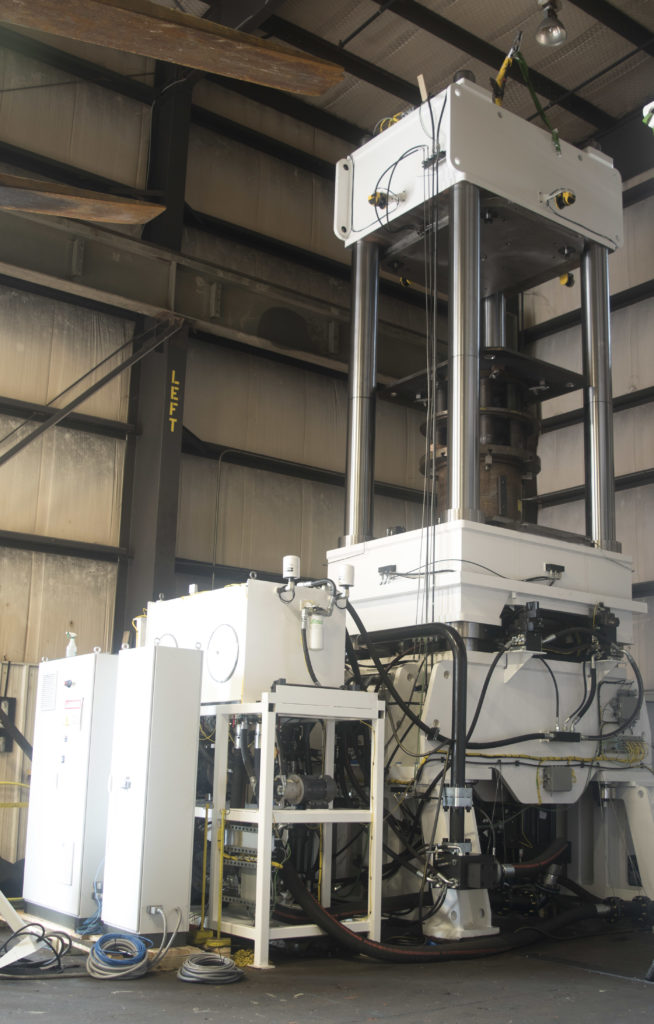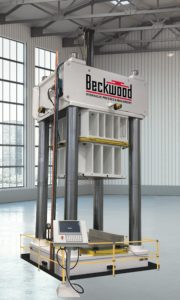Machine builder develops fully automated die handling system with 15,000-pound capacity to load and unload presses with staging tables for continuous production; die change time reduced from two hours to ten minutes
Beckwood Corporation in Fenton, Missouri (St. Louis) is a leading manufacturer of custom hydraulic presses, automation systems and the Triform line of precision forming equipment. While their machinery serves a variety of industries and applications, they excel at developing robust aerospace forming technologies engineered for accuracy and repeatability. In detailing the sophistication of their machine designs for this challenging market segment, their website includes something of a company mantra, “It IS rocket science.”
 One customer, a metalform fabricator and producer of various components for the commercial and military aircraft sectors, brought Beckwood their challenge. The company was seeking a turnkey package consisting of two 1400-ton hydraulic presses and two automated stamping die handling systems to load and unload the presses more efficiently than the conventional forklift and manual labor-intensive system this customer was currently utilizing. The presses and quick die change (QDC) workcells would be used to form a variety of parts in relatively low volumes, so the system to be designed needed a more automated die handling system. In addition, a 42”-diameter deep draw sheet hydroforming press with staging table was needed. Such a press would be the largest of its kind in the world, once produced.
One customer, a metalform fabricator and producer of various components for the commercial and military aircraft sectors, brought Beckwood their challenge. The company was seeking a turnkey package consisting of two 1400-ton hydraulic presses and two automated stamping die handling systems to load and unload the presses more efficiently than the conventional forklift and manual labor-intensive system this customer was currently utilizing. The presses and quick die change (QDC) workcells would be used to form a variety of parts in relatively low volumes, so the system to be designed needed a more automated die handling system. In addition, a 42”-diameter deep draw sheet hydroforming press with staging table was needed. Such a press would be the largest of its kind in the world, once produced.
A critical part of the challenge involved the need for a QDC system with 15,000-pound capacity to feed each 1400-ton press. As Beckwood’s lead electrical engineer John Harte explains, “We conducted a thorough review with all our local die cart suppliers and all passed on the bid, citing too many obstacles on that large a load. So, as we often do, we decided to design, engineer and build the system ourselves.” The presses each had a footprint approximately 30’ square, and the QDC would need to service the presses with T-table staging devices, allowing the next die to be prepped and ready to insert upon completion of the previous run cycle.
With the degree of automation involved, Beckwood worked with the customer’s engineering staff to devise a workcell concept comprised of two 4-post presses, each with a QDC system including a cart, rack and T-table with 15,000-pound load capacity. Each press would be over 33’ in height and positioned in a 10’ deep pit.
As the customer was a longtime user of Siemens motion control and HMI, they specified this supplier for the project. Harte connected with Derek Eastep, his account manager for Siemens, and the product list for the project began to take shape. Various drives, PLCs, displays and motion controllers were specified. The latter was a critical component, as the motion controller was required to operate all press movements, as well as the motor starters, QDC integration, light curtains that protect the workcell and operators plus area scanners that maintain the integrated safety condition monitoring on the entire cell.
The system logic and data logging setup was to be done by the customer, who had considerable experience with Siemens controls, with the Beckwood team integrating the QDC and overall cell management.
 The QDC operates in tandem with the two presses, using four 15HP motors to drive the lead screws on this massive die handling system. They are electrically geared through the onboard Siemens PLC to move the ram and shuttle. Additional motors and drives on the feed tables allow the next die to be positioned during press operation. When a press cycle is completed, the air bags on the feed tables lift the next die for positioning onto the QDC, then a shuttle inserts the die inside the press, with all motion controlled by the PLC. These T-tables and the QDC were designed, engineered, built and tested by Beckwood at their factory prior to shipment and installation at the customer’s facility. Both Beckwood and Siemens personnel were active in the commissioning of the entire system.
The QDC operates in tandem with the two presses, using four 15HP motors to drive the lead screws on this massive die handling system. They are electrically geared through the onboard Siemens PLC to move the ram and shuttle. Additional motors and drives on the feed tables allow the next die to be positioned during press operation. When a press cycle is completed, the air bags on the feed tables lift the next die for positioning onto the QDC, then a shuttle inserts the die inside the press, with all motion controlled by the PLC. These T-tables and the QDC were designed, engineered, built and tested by Beckwood at their factory prior to shipment and installation at the customer’s facility. Both Beckwood and Siemens personnel were active in the commissioning of the entire system.
The PLC is a Siemens S7-1515—a robust controller that integrates function control, safety and condition display in a single module with Profinet protocol for bus communication. Through the TIA Portal and Step 7 software provided by Siemens, the end user can customize the operation of the devices remotely, integrating multiple part files and related safety commands in one controller. This “library” feature allows the end user, as they run a variety of parts during a shift, for example, to use one software package to program quickly and more efficiently. Likewise, the safety switches on the entire system are programmed through this secure and redundant safety back-up software through the TIA Portal.
All motor movements on the twin four-post presses are controlled with Siemens drive technology. In operation, the Beckwood presses with the QDC systems are expected to reduce die setup and changeover from approximately two hours to ten minutes.
As Derek Eastep from Siemens notes, “Because the end user was a longtime customer, we performed the application engineering with Beckwood and their customer, fully confident that the system would be set up and running in a relatively short time, as all parties had good familiarity with our protocols.” Harte adds, “We used the Selector, Sizer and Starter engineering tools from Siemens to spec and then commission the drives, which saved us a substantial amount of time. It made our lives a lot easier,” he muses.
The two 1400-ton presses in the workcells are Beckwood’s robust four-post frame style with replaceable, graphite-impregnated bronze bushings and solid chrome-plated posts to ensure precision ram guidance. Designed to form parts with challenging geometries in low-volume, high-mix production environments, the 42” Triform deep draw sheet hydroforming press will be the largest press of its kind in the world.
 Josh Dixon, director of sales & marketing at Beckwood, says in the company video, “We hate the word ‘no’.” The success of this unique and first-of-kind press and QDC workcell, built by Beckwood with the help of its controls supplier Siemens, bears out that statement.
Josh Dixon, director of sales & marketing at Beckwood, says in the company video, “We hate the word ‘no’.” The success of this unique and first-of-kind press and QDC workcell, built by Beckwood with the help of its controls supplier Siemens, bears out that statement.
Due to the versatile nature of Beckwood’s “built to order” business model, their machines are engineered to serve a variety of industries. Beckwood’s extensive experience serving so many industries provides a unique vantage point that customers find incredibly valuable. They are often able to recommend process improvements that customers may have never known or considered, revolutionizing their manufacturing operations. Beyond metal forming, the company also manufactures presses used to form rubber, plastic, composites and other material substrates. The business started in 1976 and is today led by company president Jeff Debus.
About Siemens USA
Siemens Corporation is a U.S. subsidiary of Siemens AG, a global powerhouse focusing on the areas of electrification, automation and digitalization. One of the world’s largest producers of energy-efficient, resource-saving technologies, Siemens is a leading supplier of systems for power generation and transmission as well as medical diagnosis. With approximately 348,000 employees in more than 190 countries, Siemens reported worldwide revenue of $86.2 billion in fiscal 2015. Siemens in the USA reported revenue of $22.4 billion, including $5.5 billion in exports, and employs approximately 50,000 people throughout all 50 states and Puerto Rico.
For more information on this story, please contact:
BECKWOOD CORPORATION
889 Horan Drive
Fenton, MO 63026-2405
P: (636) 343-4100
www.beckwoodpress.com
Attn:Christie Williams, Corporate Marketing Manager
marketing@beckwoodpress.com
-OR-
Alisa Coffey
Siemens Digital Factory
MarCom Manager of Aerospace, Automotive, and OEMs
5300 Triangle Pkwy
Norcross, GA 30092
(678) 427-8319
alisa.coffey@siemens.com


















